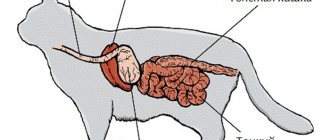Some of the saddest and at the same time ridiculous stories begin something like this: “Our Murka has always been an affectionate cat, but yesterday she almost scratched her eyes out.” Most owners who have experienced what aggression is like in cats don’t even think about the fact that it’s not Murka’s fault. Cats, for the most part, are calm and affectionate creatures that show aggression only for the purpose of self-defense. If your pet hisses, scratches, bites, or shows hostility towards you, family members or guests, you should not blame the animal, you need to look for reasons.
Defensive aggression of cats
Often the aggressive behavior of cats is associated with a self-defense function. Such aggression is purely reactive in nature and is a defensive reaction to anything associated with danger or pain.
There are three main types of aggression:
- 1. Defensive-aggressive reactions to threat i.e. aggressive behavior by another cat or person, such as when one cat is seriously threatened or attacked by another cat or when a person punishes a cat by hurting it.
- 2. Antisocial reactions, when a cat behaves aggressively in order to interrupt or prevent unwanted contacts with relatives or people (for example, an animal of the same color causes aggression in the cat due to a negative experience of communicating with another cat of the same color in the past. Or a certain person is associated with pain and also causes fear).
- 3. Aggressive reactions in situations of competition, when, for example, one cat hisses threateningly at another, in connection with some of its actions.
Active aggression of cats
Aggression can also be more active or offensive in nature. In such cases, the cat initiates aggressive confrontations with another cat or person who is not a threat to it - these are attacks during play (often found in young cats). Aggression during play is also a source of so-called instrumental aggression, i.e. aggression as a means to achieve a goal.
Active aggression, unprovoked, and sometimes violent attacks seem to indicate a zero tolerance for the presence of another cat. This type of aggression is observed mainly when a cat attacks a new cat that has recently appeared in the house, or a cat that previously showed aggression, but lost its position due to certain reasons. The main function of aggression in such situations is to expel the object of aggression. Therefore, these forms of aggression are designated as territorial aggression.
Aggression between cats living in the same house
Every owner knows that a scared cat can be very dangerous. This extreme state of fear is easy to identify: the pupils are dilated, the ears are flattened, the cat presses itself to the floor, retracting its head and tucking its paws, and begins to hiss and growl. Its readiness to attack is demonstrated by its flattened ears, dilated pupils, arched back and raised fur. The object of such defensive aggression may be another cat, dog or person. The cat, being an initially non-conflict creature, attacks only when an object that inspires fear comes too close to it.
Defensive aggression caused by fear and directed at people is rare, most often in cases of treating a fearful cat (treating a wound, giving medication, etc.). The cat, in this case, must be left alone until it calms down.
Redirected aggression
The pet attacks the nearest living creature, angry at an animal or object that is inaccessible. For example, a ward watches a cat from the window, begins to bang its tail, hiss and raise its fur. If at this moment, you or another animal “hurts” the aggressor with something, all the anger will be redirected.
Even after the pet has “let off steam”, it remains in an irritated state. It’s as if he’s walking around the house asking: “Well, who else should I kick?” There are few options for eliminating redirected aggression - isolate the animal after an outburst of anger (temporary), sterilize it, or use sedatives.
Conditioned reflex aggression of cats
Mutual threats and fighting in general tend to increase fear in both cats and thus also lead to an escalation of fear-based aggression. The best measure to correct this problem is to eliminate problematic situations.
Some owners assume that cats are fighting in a struggle for leadership and, if you do not interfere with the fight, the problem will solve itself. This opinion is erroneous, because in these cases it is the prevention of any clashes and mutual threats that is decisive for the successful prevention of the problem. Feeding cats together and especially playing with them frequently will help reduce fear, as it is incompatible with eating and playing.
In particularly severe cases, one of the cats is placed in a cage for several hours every day, while the other gets the opportunity to move freely around the apartment, getting used to it and not feeling fear. Another method can give results: cats are placed in two cages standing next to each other for several hours every day. This method is used for a long time, eventually, the fear reactions weaken, and the cats gradually learn to eat, live, play, etc., in the presence of each other without fear.
If the problem is not just a temporary phenomenon of clashes and mutual threats, it is advisable to keep cats separately.
When to contact a veterinarian
Sometimes the owner is not able to accurately determine the reason why the cat behaves aggressively.
Be sure to read:
How to scare cats away so that they don’t shit, mark and damage furniture, what smell they can’t stand
It’s time to go to the veterinarian in cases where the pet behaves strangely, constantly sits in one place and attacks if you approach it. Feeling unwell may be a sign of a serious illness.
Below is a table of the main diseases in cats:
| Sign | Cause |
| The cat sits still in one position, reacts aggressively to touch | Arthritis |
| Lying down, doesn’t want to move, won’t let you get close | Physical trauma |
| Falls over when walking, can crash into furniture, scratches and bites | Brain injury |
| Runs around the apartment, suddenly pounces and bites, meows loudly | Hormonal disbalance |
| Avoids bright light, tries to hide in a dark place, jumps on the owner, bites painfully, can attack at night, the animal has increased salivation | Rabies |
Cats also become aggressive during periods of sexual activity and increased levels of thiamine in the blood. In this case, the veterinarian will recommend medications and diet to eliminate the pet’s aggression.
Aggression to a negative stimulus in cats
The basis of a cat's protective behavior is not necessarily conditioned reflex fear. Even a balanced, affectionate cat can display defensive aggression in response to a negative stimulus. How else can you react to a tail pressed by a door, a heel on a paw and other horrors of living together?!! In this case, pain may prompt the cat to react defensively. She will put out her claws or start biting. This should be remembered when young children, unsupervised by adults, are attacked by a cat while playing. For the same reason, a bite from one angry cat can cause an aggressive reaction in another cat.
There are also frequent cases of aggression caused by stroking for too long, which is unpleasant for the cat. Different cats have different attitudes towards stroking with their hands: some of them are vitally important, and they are ready to lie on their owner’s lap for hours, others tolerate it depending on their mood, patience is exhausted, cats bite the hand and jump to the floor to run away. As they say, nothing personal. These are purely individual preferences and therefore it is necessary to avoid actions that cause a negative reaction from the cat.
To do this, you need to be able to recognize signs that indicate irritation (for example, tail movement, restlessness, pinned ears).
How to stop a cat from biting, scratching and hissing
Having decided to start raising a pet, the owner must monitor the condition of his pet.
Be sure to read:
Why cats hiss: the main reasons, what to do, how to calm them down when they are aggressive towards a certain person
It is advisable to stop aggressive behavior if possible:
- shout loudly at the cat;
- make a sharp, ringing noise with a handy object;
- make a clap with your hands.
Sharp sounds will scare away the animal, forcing it to stop trying to bite the owner's hand.
You can also use a spray bottle of water, sprinkling it on the cat when biting. When trying to scratch your hand or furniture, it is recommended to use a towel or rag. You should throw a cloth over the enraged cat, thereby catching it by surprise.
Territorial aggression of cats
Territorial aggression differs from defensive aggression in that the actions of the aggressor are determined not by fear, but by completely different motives. At any opportunity, a terrorist boldly pursues his opponent and attacks him.
In the case of classic territorial aggression, the aggressor does not show the slightest sign of fear before the attack and, more often than not, persistently seeks confrontation, using every opportunity to attack. This is how a new animal can be welcomed into the house. This problem usually appears between one and three years of age and can also occur in cats that previously got along well with each other.
Sometimes cats, without showing fear, attack house guests. This is an example of active aggression directed at people, which suggests some kind of defensive motivation underlying this behavior.
If, when correcting the classic form of territorial aggression (where one cat fearlessly, constantly stalks, chases and attacks an extremely fearful victim), all measures taken have not achieved results, the only reasonable solution will be to find a new owner for one of the cats.
Maternal aggression
Perhaps this is the only option when a person should not try to correct the behavior of an animal. An angry mother cat is capable of not only attacking, saving the lives of the kittens, the animal will “stand to the death” and fight to the last drop of blood. Before the attack, the mother emits a specific odor, elusive to the human sense of smell. If you have multiple pets in your home, they will instinctively stay away from a nest with kittens, you should do the same, at least until the babies are 2 weeks old.
What to do if a cat that has recently given birth regularly attacks its owners? Firstly, be patient, and secondly, discover and eliminate the cause of the cat’s fears - move the nest to a quieter room, darken the room, refrain from receiving guests. If the cat is preparing to attack, retreat without turning your back to the animal, show open palms and do not try to speak, the mother’s priority is to eliminate the “enemy” without a fight.
Aggression between cats
Aggression between cats can be considered a form of active or territorial aggression. In the wild or in conditions of partial freedom, cats quite clearly demonstrate territorial behavior, often reacting aggressively to each other. When two unfamiliar cats meet, they may demonstrate ritualistic threatening postures and movements. Their body is like a stretched bowstring, they stand opposite each other on outstretched legs, without taking their eyes off each other. At the same time, their ears are pressed back and turned back. They shake their heads, purr and, grinning, open their mouths. If one of them stops threatening the other and begins to slowly retreat, the fight may not take place.
If several conflicting cats live in the same house, you can try to apply the behavior correction methods already discussed above (for forms of defensive aggression) to them. If this does not bring a positive result, the owner can only give away one of the cats, or castrate them both. In most cases, as a result of castration, their aggression disappears, or at least weakens, in the absence of a reason for the dispute. However, their mutual intolerance may be much deeper. In this case, castration does not solve the problem. Therefore, if aggressive behavior does not stop, then no behavior correction measures will help. In this case, owners can be advised to keep only one animal in the house.
Intraspecific aggression
Sometimes we hear the squeals of cats clinging to each other under the windows, ready to make any sacrifice to defeat their opponent. After such battles, doubts begin to arise about the prevalence of peaceful solutions to the conflict over confrontation among cats. But it's not that simple.
Rivalry between cats does not occur because of “harmfulness”, but due to the implementation of a number of instincts
The struggle of cats who find themselves in the same territory is directly related to the instinct of self-preservation. A defeated cat risks being expelled and left to its own devices. Why do these animals pull out each other's hair?
There is a continuous struggle with competitors for both status and territory.
Firstly, every fight is a matter of status. It is more expensive for yourself to be in last positions in the hierarchy. Secondly, the outcome of the collision will directly affect the cat’s future territory of residence. In cat fights, the stakes are always high, and it doesn’t matter whether it’s a fight for a piece of forest for hunting or for a cozy corner by the stove. Territorial aggression can also manifest itself towards a stray cat with whom your pet is playing an intense game of staring contest.
By the way! In addition to direct clashes, animal aggression towards each other can manifest itself indirectly. For example, by marking the territory by spraying urine.
Reasons for displaying aggression
Among the situations in which aggression occurs between cats within the same home, the most common are the following:
- the arrival of a new pet in the family;
- competition for limited resources (food, resting place, love of the owner, litter box);
- long absence of a previously familiar pet.
The reasons for confrontation can be very different - from the owner’s attention to one’s own litter box.
From this we can conclude that intraspecific aggression can arise both between unfamiliar animals and between animals that have lived under the same roof for years. Sometimes even a long absence of a pet is not necessary - cats that have lived in perfect harmony can suddenly cling to each other for the owner.
What can the owner do?
In intraspecific clashes, the role of the owner is minimal, so he cannot always influence reconciliation. Clashes can worsen during periods of hormonal surges and resolve on their own.
If the owner does not have the opportunity to isolate the cats from each other, castration may be a compromise.
In extreme cases of rejection, it may be worth considering moving one of the pets to a safer location. It is also advisable to take into account the size of your home and the distribution of active zones for each cat. The less space you have, the fewer pets you should have to avoid competition.
You can effectively reduce the level of aggression through castration, after which it will be easier to calm your pet. However, for those who plan to raise a cat dynasty, this method is hardly suitable.
Rough cat play
If the only cat in the house is left alone for a long time, then due to its unspent energy, one can observe an excessively high playfulness of the animal. Attacks on owners during play indicate a lack of communication. The same problems arise from rough and improper games with a cat. They can also cause the cat to attack family members, encouraging it to behave aggressively.
As a distracting maneuver, inexperienced caregivers sometimes throw toys at the cat, which only encourages the animal to continue playing and increases its desire to attack its owner. In this case, you should persistently and consistently stop such cat games in every possible way.
Breeds of the most aggressive cats
Animals go into a rage under three conditions: pain, fear, or in the heat of competition. The most aggressive cat breeds are Siamese, Angora, British, Persian.
Siamese cats
The breed is distinguished by vindictiveness and a desire for revenge. Owners of Siamese cats are often attacked and left with bitten or scratched. If a representative is unintentionally or deliberately offended, then he can harbor anger for the rest of his life and rush at every opportunity.
Siamese do not tolerate neglect and familiarity, or excessive attention to their own person. Such pets are not recommended for families with small children out of fear for the children’s health. Animals do not tolerate competition - if there are other cats in the house, then it will quickly begin to resemble a war zone.
The main option for a Siamese cat is a single person who can cope with the pet's outbursts. In this case, an ideal tandem is obtained - peaceful coexistence without constant conflicts.
White cats
Mental instability may be associated with a defective cat - most snow-white cats with blue eyes suffer from deafness. Vulnerability, fear and the instinct of self-preservation lead to constant hostility without reason or external stimuli. Cats defend themselves just like that, without serious reasons.
White aggressive cat
Blue cats
Pets, painted in gray-blue colors, are naturally distrustful and timid. Attempts to show persistence on the part of a person end in “licking” wounds from claws and teeth. Remembering the aggressive breeds of domestic cats, we can say that anger is inherent in the Persian and British breeds - their freedom-loving nature does not allow them to obey and do something against their wishes.
The British have a rich imagination and changeable moods. Before attempting to invade the personal space of a breed representative, you need to make sure that he is in a good mood - otherwise you may receive a warning hiss and a sharp blow with a paw with extended claws.
Veterinarians believe that most attacks on people are provoked by competition for the right to be called the alpha male in the pack. In males, testosterone is released along with sweat, in females - estrogens. They cause bursts of rage that arise under the influence of sexual instincts. It has been noticed that females attack women more often, while males attack men. Lonely people are better off having pets of the opposite sex: the smell of sweat from a person causes sexual arousal and the production of endorphins.
Aggression in cats does not arise due to the bad character of the furry pet or gloomy mood. If you correctly determine the source of the problem and remove the irritants, you don’t have to worry about the integrity of your skin—the pet won’t attack its owner.
War with the aggressor (cat)
For any attack, the cat must be punished immediately. For example, she can be strongly scolded, sprayed with water from a water pistol or sprayer, or scared with a loud sound (clapping hands, rattles, etc.).
The distracting stimulus must be strong enough to stop the aggression instantly. At the same time, the punishment should not be too severe, otherwise the cat, frightened, will hide and remain in ambush for a long time. For aggressive behavior, the cat should be punished immediately after the attack (i.e. within 1-2 seconds). A very active and playful cat needs to move more, which will weaken its desire to attack its owner.
When a cat is left alone, it must have toys at its disposal that it loves to play with. The best thing you can do to ensure that your cat doesn’t get bored and has the opportunity to realize its energy is to get a few more cats! To meet the cat's play and exercise needs, it is very helpful for the owner to set aside time for daily play with the cat.
The cat behaves aggressively: we are looking for the reason
In fact, by nature, domesticated felines are affectionate and playful. All you have to do is pet the fluffy sissy, and he will jump onto your lap and announce his good-natured attitude with a loud purr. What to do if the picture observed by the owners every day is far from the described idyll, and the residents of the apartment have to fight to win their personal space and avoid the pet?
Most often, a cat’s aggressive behavior is a problem whose roots go deep into your pet’s childhood. If he grew up in an environment of warmth and care, you will not have to deal with anger and hissing in response to the desire to play or pet the cat. However, there are cases in which an unpleasant character trait directly depends on the breed. So, many of us have heard more than once that Siamese cats are one of the wildest and most difficult to train. The Persians and the British differ in their stubbornness and freedom-loving disposition.
What else can influence a pet's behavior? Here are some interesting facts that confirm that anger cannot be without cause.
- White cats are considered one of the most aggressive. Why? They say that this feature of their behavior is associated with the predominance of Angora blood.
Interesting fact
Angoras themselves often suffer from deafness. This feature affects their character - they constantly feel unprotected (they cannot hear the approach of the offender), so they are always on guard.
- The capriciousness and willfulness of seals and cats of all breeds in most cases can be explained quite simply: animals do not like being treated with familiarity. Young children should be especially careful: children often forget about everything in the world and selflessly squeeze their pet, not even realizing that they can cause him pain or discomfort. It should be explained to the child in advance: a cat is not a toy, but a living creature, and it must be treated with respect and attention.
Instrumental behavior of cats
Sometimes cats use aggression as a kind of tool (cats use it as a tool or strategy in their pursuit of a goal). Problems associated with begging, intrusiveness and the cat's desire to attract attention sometimes become a disaster.
For example, the owner has to wake up at night and satisfy the desires of his cat. Feed her or play with her until she calms down and allows him to fall asleep. The lack of a desired reward may cause her to react negatively (for example, demanding meows).
To stop any unwanted forms of cat behavior, you need to once and for all determine for yourself who is intended for whom. The cat is for you or you are for her. And based on the decision made, build further relationships. In all cases, your coexistence should be built on mutual respect. At the same time, having banned something once, you should continue to be consistent in your actions. Only then will the cat learn the futility of its excessive claims. You should not change your positions until the cat's behavior is completely corrected.
Call a veterinarian to your home 24 hours a day
Why does a cat behave aggressively: what happens after birth
Females experience pregnancy while under constant stress. After carrying kittens and giving birth, the pet’s behavior often changes: a previously playful and affectionate cat may attack the owner, bite or scratch him.
photo from website: icatcare.org
It is important to remember that any irritants can traumatize the psyche of your pet, who is going through one of the most difficult periods in her life. So, it is necessary to exclude all loud sounds and do everything to ensure that the animal does not experience anxiety and stress. If you notice that your mother is looking for a secluded place, let her rest and do not disturb her.
Why did the cat become aggressive after giving birth and what to do? A veterinarian can answer this question. Sometimes the doctor prescribes special means to improve the animal’s well-being and relieve irritability:
- pheromones;
- catnip;
- anxiolytics - only under the supervision of a specialist.
Recommendations for stopping aggression in cats
For example, to correct the frequently recurring form of instrumental behavior of a cat that constantly wakes up its owner in the middle of the night, choosing him as an indispensable participant in its games, you should try the following actions:
- Leave it outside the bedroom door at night.
- Under no circumstances should you open the door for her, even if she meows and tries to knock down the door.
- Do not respond to the cat's complaints. (Don't talk to her or make any noise).
Most likely, during the first few nights, the cat will experience severe stress due to being expelled from the bedroom, and its behavior will worsen even more. This is fine. You just need to show more persistence than she did, and sooner or later your tormentor will calm down her claims.
After a few quiet nights, you may unthinkingly relax, imagining that your invader has finally given up trying to spend the night with you. It's an illusion! As soon as he gets into the coveted room, everything will start all over again.
In fact, the creature you abandoned will continue to try to impose its company on you for a long time, sneaking into the bedroom. Be strong! The main thing in this situation is never to give in, and then attempts will be repeated less and less over time and will stop completely when the cat is finally convinced of the futility of its intentions. However, hope dies last.
Aggressive behavior in cats: prevention and treatment
Contents hide
Aggressive behavior in cats: prevention and treatment
Today we, dear readers, will talk about deviations in the behavior of cats. In letters from many of our subscribers there are complaints about unmotivated aggression in furry pets. At one point, we realized that we should prepare a separate material - the topic turned out to be so relevant. We give the floor to our colleagues from America.
The problem really exists: until recently, an affectionate and calm cat suddenly changes its behavior to a minus sign, rushes at its owners, bites and scratches. Let's figure out where cat aggression comes from.
General idea. Aggression in cats is the most common behavioral problem, and it is, unfortunately, as old as time. Moreover, what we call aggression actually fits perfectly into a cat's nature. In most cases, negative changes in a cat’s behavior can be corrected directly at home. You should seek the help of professional specialists and use medicinal treatment methods only when the animal becomes downright dangerous.
“Aggression in cats” is a collective concept. There are many reasons for the aggressive behavior of our furry pets: fights between cats; territory protection; fear/defense; aggression during games; predator instinct; redirected aggression, some other reasons. In all of the above cases, the animal can be helped. If it doesn’t work out, then we’ll treat it.
The first step is to talk to your veterinarian. It is necessary to know his opinion about the nature of your pet’s aggressive behavior. The doctor will help determine whether serious intervention is required; perhaps the aggression is hiding some serious illness. Once it becomes clear that the problem is behavioral, you should move on. Perhaps your attending veterinarian will give you some practical advice, or he will advise you to make an appointment with a specialist.
Symptoms and identification. Cats are quite complex and sometimes contradictory creatures. There is no need to hope that you will be able to get to the bottom of the negative changes in their behavior right away. Moreover, aggression must be diagnosed, separating it from normal cat behavior: many animals have a “tough” disposition from a very young age. You'll have to come to terms with the fact that you just came across such a pet. However, let's move in order.
A cat exhibiting fear or defensive behavior is a behavior that almost all owners can experience. How does your pet behave when he realizes that he is going to the vet? The animal first arches, and then, as it were, everything shrinks, tucks its tail under itself, and its ears move back.
Objects of aggression are other animals (cats). Does your pet spend most of its time outside? Then he has something to “talk” about with the neighbors’ cats. Do you have several cats in your home and are you keeping them indoors? And this happens - animals simply cannot get along.
Your cat fighting on the street is a normal behavior for unneutered street cats. Cat fights occur at lightning speed: cats sort things out over territory, over food, over beautiful ladies, etc.
Aggression as a defensive reaction to the pain experienced. You will receive a strong rebuff from a sick pet if you try to cuddle it or pick it up (options are possible).
Play aggression. Most often occurs during games between cats. Aggression is also possible towards the hosts when they go a little too far during the game.
Aggression as a manifestation of the predator instinct. Actually, cats have always been and remain predators by nature! See how a cat behaves when it tracks, chases and finally catches its prey - small rodents and birds. However, cats sometimes “forget” who they are dealing with and begin to play predators with their owners. A sudden jump or throw, a strong bite, a cat holding the “prey” with its teeth, trying to “shake” it - all this is, to say the least, very unpleasant. Kittens absorb this behavior with their mother's milk, and hone their first hunting skills on their brothers and sisters.
Redirected aggression. This phenomenon is also common. How does this happen? Your cat, for example, may quarrel with the neighbor's cat and hatch plans for revenge. But he soberly assesses his own capabilities - his offender is larger, stronger, and you cannot take him with your bare paws. And evil accumulates! And then the animal unleashes all its rage on someone else - for example, on another weaker cat, or on a neighbor, if you have several cats at home.
Territorial aggression. Everything is clear here: your cat will defend its territory from claims from other cats.
Petting-induced aggression. Often it literally comes out of nowhere. You caress your pet, it purrs sweetly and seems to be happy with everything. Suddenly he bristles sharply and inflicts very painful bites. As experts joke, “a cat bites out of great love,” but this doesn’t make it any easier for the owners. By the way, the nature of this phenomenon has not yet been very well studied.
How is the diagnosis made? The veterinarian follows a standard path: he clarifies the sex of the animal, whether it was castrated/sterilized, when and under what circumstances aggression first appeared, and whether there are negative dynamics in behavior.
The breed of the animal is not specified - aggression manifests itself in animals of all breeds without exception.
Treatment. In many ways, as noted above, it depends on the type of aggressive behavior. In the vast majority of cases, corrective techniques work well. You will be advised to spay or neuter your animal if these operations have not been performed before. In advanced cases, the veterinarian will use drug treatment. If you doubt your abilities, on the advice of a veterinarian, be sure to visit specialized specialists (in cat behavior, for example).
Prevention.
In many ways, the root cause of aggression is the lack of proper attention to the animal on the part of the owners. Most often, cats become aggressive when left to their own devices, whose owners have decided that their main mission is to put food in the bowl on time. You should work with a kitten from a very tender age, socialize it, teach it to live in a large and complex world where you will have to interact with other people and animals. Care and housekeeping are your main preventive measures! Original publication: Aggression in Cats. Source and photo:
Knowing everything about the causes of aggressive behavior in cats, what should you pay attention to?
Exhibition
It is necessary to create a comfortable atmosphere. Remove heart-rending screaming cats from the exhibition hall - they turn on themselves and turn on the others. It has been noticed that after the squeal of one “scandal,” half of the animals “go crazy”: even the calmest ones begin to howl and rush—the crowd effect.
Breeders
It has been noticed that aggression is often found in cats whose owners are stubborn, nervous, and constantly looking for scandals. It is useless to persuade such owners to leave the cat alone, because if the animal’s reaction to the exhibition is negative (howls, squeals, tries to tear everyone apart), it means, to put it mildly, “she is a stranger at this celebration of life.” Have pity on your cat - she DOESN'T LIKE it here! She's suffering! Alas, such arguments do not work on ambitious owners, and championships are achieved at ANY cost!
Cat breeds
There is no pattern between aggressiveness and breed. At the beginning of cat breeding in the USSR, Angoras were considered a “thunderstorm for exhibitions,” but even a British cat can bite. Any experienced expert will tell you that the most difficult thing to judge in the ring is domestic cats - they are not used to exhibitions.
Theirs and ours
The requirements for the exhibition temperament of cats at exhibitions in Europe and the USA are much more stringent than at domestic ones. Firstly, the rules are followed, and therefore it is IMPOSSIBLE to get an assessment from the judges of a howling and screaming pussy “in a cage” with good obscenities. Secondly, club chairmen value experts and take care of them, without calling them to become matadors and rush into battle with a raging “exhibitor”. And their judges are insured.
Dear exhibitors! Remember, judges are not required to judge aggressive cats. Take care of your health and theirs.
The innate aggression of cats cannot be corrected!!!
On my own behalf, I would also like to add that everything described above applies to the so-called domesticated cats. So who else, you ask?
So that you correctly understand what we are talking about, I will give an excerpt from a manual on breeding a Bengal cat. This breed was bred relatively recently and the genes of its wild ancestors are still very strong:
“…..Different breeders pay attention to different traits of the breed. So how big are the differences? They are very big. Bengals with a high content of wild blood, the closest to the leopard cat, vary greatly, each of them is unique. F1 is the first generation obtained from crossing a leopard cat with a domestic cat. This generation is completely indomitable and unfriendly. Only very experienced specialists can try to keep them. These cats cannot be pets. Females often kill their offspring. For these kittens (F2 - the second generation from a wild cat), it is vitally important to feel human touch before 4 weeks. If this is not done, they will also become wild. Despite their nasty habits, F1 kittens are needed to establish various lines of Bengals. Some breeders place great importance on the percentage of wild blood in their line. These are important factors for those who are obsessed with the idea of owning a wild cat." ……
It is also necessary to know that a cat, as a species, does not change over generations as much as a dog. If a domestic cat gives birth to kittens, for example, in the forest, then without seeing a person they will become completely wild. This means only one thing - the cat inexplicably carries the wild gene (let's call it that) in a latent form for thousands of years.
Now imagine that a domestic cat gives birth to a kitten in which this gene has awakened. And then this kitten was sold to you. Unfortunately, such cases are not uncommon and often end in tragedy. Such an animal cannot be calmed by sterilization, since sterilization only removes sexual aggression. Similar babies are also born to dogs (we have all heard about dog attacks on children), this problem is also encountered in sport horse breeding, etc. Moreover, a wild animal always attacks the weak - children. For such an animal, a person is at best an enemy, at worst, prey. Don't even think about flattering yourself - you will never tame a wild cat. And the question of whether this cat will attack you or your relative is a matter of time.
Have I scared you enough yet? All of the above applies to all breeds, but I want to remind you that the Maine Coon is a native cat and is quite large. And she also lives and sleeps, perhaps on your bed. Be carefull. Don’t believe it when they tell you that Maine Coons are ALWAYS VERY KIND AND AFFORDING. Unfortunately, this is not always the case. If a kitten is wild, it will grow up wild.
What to look for when choosing a kitten
When choosing a kitten, do not do it spontaneously! Don't "fall in love" with the first baby you like. Call several nurseries. Carefully examine how social your kitten is. Isn't he being shy? If he hisses and growls at you, hiding like a wild one, this is a very bad sign. Usually such a kitten stands out among its brothers and sisters for its unfriendliness.
Do not hesitate to ask the breeder what temperament the father and mother of the kitten you are planning to purchase have, if possible, talk to them. There are, of course, just cats that are cowards, so you won’t communicate with them, but this does not apply to aggression.
Ask where the litter was raised and whether the kittens had close contact with humans before 1.5 months. Kittens must “dangle underfoot” throughout their childhood so as not to become feral. The wild gene is also awakened by repeated random inbreeding, which many domestic breeders, unfortunately also famous ones, are guilty of. Do not buy strange mestizos of unknown origin. Don’t forget also that fifteen titles and fifty judges’ ratings from the kitten’s parents also say ABSOLUTELY nothing about its temperament. Fortunately, this type of aggression is relatively rare.
Be literate and smart shoppers. Don't be fooled. If you just pay a little more attention, you'll save yourself the hassle and make a wonderful friend
Features of cat aggression
It is well known that cats are not the type of animal that will show aggression for the sake of aggression itself. Even the most severe predators among felines will prefer retreat to any confrontation. From this we can conclude that in most episodes, aggression is caused either by the owner himself or by circumstances disturbing the cat.
Cats prefer to wait out danger in secluded places.
At this point, confusion may arise. You gave your pet all the best, petted it, fed it, carried it in your arms, and in response it waved its claws. In addition, you also find yourself guilty. Where is the justice?
Cats continue to fight for survival both in the snowy taiga and in a heated room
As already mentioned, each pet has certain behavioral patterns, certain reactions that it produces to certain stimuli. If you seem potentially dangerous to him, the cat will forget about everything you have done for him and turn on the instinct of self-preservation. For example, if there is a lack of shelter hidden from prying eyes, the cat may begin to experience stress and show increased aggression in seemingly safe conditions.











